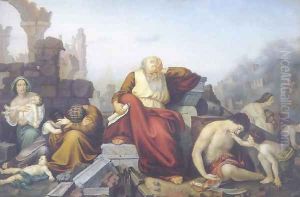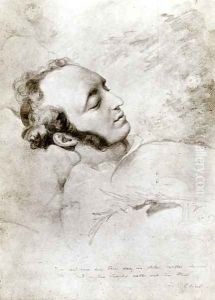Eduard (Julius Friedrich) Bendemann Paintings
Eduard Julius Friedrich Bendemann was a notable German painter born on December 3, 1811, in Berlin. He emerged from a family with Jewish roots; his father, Anton Heinrich Bendemann, was a banker, providing a well-to-do backdrop that afforded the young Eduard a comprehensive education. The Bendemann family's move to Dresden in 1819 marked a pivotal moment for Eduard, as it was there that he first engaged with the arts, eventually enrolling at the Dresden Academy of Fine Arts. His talents were nurtured under the guidance of Caspar David Friedrich, a leading figure in German Romanticism, and Johann Friedrich Overbeck, a key proponent of the Nazarene movement, which sought to revive honesty and spirituality in Christian art.
During his formative years, Bendemann's style began to reflect the influences of his mentors, combining the emotional depth of Romanticism with the Nazarenes' devotion to religious and historical subjects. His early works, characterized by their meticulous attention to detail and vibrant emotionalism, quickly garnered attention. In 1832, he achieved significant acclaim with his painting 'The Two Girls at the Well', which solidified his reputation as a rising star in the German art world.
Bendemann's career took a significant turn in 1838 when he was appointed as a professor at the Düsseldorf Academy of Arts. This position not only marked him as one of the leading figures of the Düsseldorf school of painting but also allowed him to influence a generation of artists, including Hans Gude and Andreas Achenbach. His work during this period continued to explore historical and biblical themes, with notable works such as 'Jeremiah on the Ruins of Jerusalem' reflecting a matured mastery over emotional expression and compositional arrangement.
In 1859, Bendemann was appointed director of the Düsseldorf Academy, a role he held until 1867, when he moved to Dresden to become the director of the Royal Art Academy. His tenure in Dresden was marked by efforts to reform the academy's curriculum, emphasizing practical artistry and historical study. Despite facing resistance from traditionalists, Bendemann's reforms laid the groundwork for modern art education in Germany.
Eduard Bendemann's contributions to German art were not limited to his paintings; his leadership roles at two of Germany's most prestigious art academies had a lasting impact on the development of 19th-century German art. He passed away on December 27, 1889, in Düsseldorf, leaving behind a legacy that was not only cemented in his poignant and evocative artworks but also in his profound influence on the generations of artists who followed him.

